14 Superfoods That Sculpt a Flat Belly

Superfoods are big news, including in the weight management world.
What are 'superfoods,' you may ask? 'Superfood' is not a scientifically recognized term, and there are no set criteria. However, foods with this label tend to be rich in vitamins, minerals, and antioxidants. Antioxidants take center stage for good reason. They protect our cells from oxidative stress from free radicals at-large in the body. Think of free radical damage as 'cell rust,' like what happens to metal left to the elements. The 'rust' is what may lead to problems down the road (like cancer). Many superfoods contain fiber, protein, or heart-protective fats as well.
Here, using my background as a Registered Dietitian for Top Nutrition Coaching, I'll focus on superfoods linked to fat loss, including belly fat (visceral fat, a harmful type (1) when in excess). Let's dig in (pun absolutely intended)!
Kale and other dark green leafy vegetables (Swiss chard, collards, mustards, spinach)
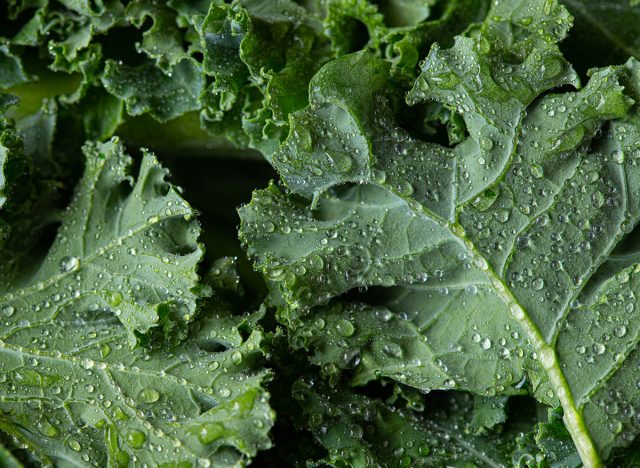
Green leafies like kale (2) are loaded with Vitamins A, C, and K along with fiber, calcium, and other minerals. Eating spinach regularly (3) may cut your risk of developing conditions like type 2 diabetes and excess weight, thanks to its antioxidants and fiber content. Greens keep your digestion chugging along with their insoluble fiber–helpful in preventing a bloated belly.
Related: 5 Signs You Are Burning Fat, Not Muscle While Exercising
Berries (blueberries, raspberries, strawberries, blackberries…)
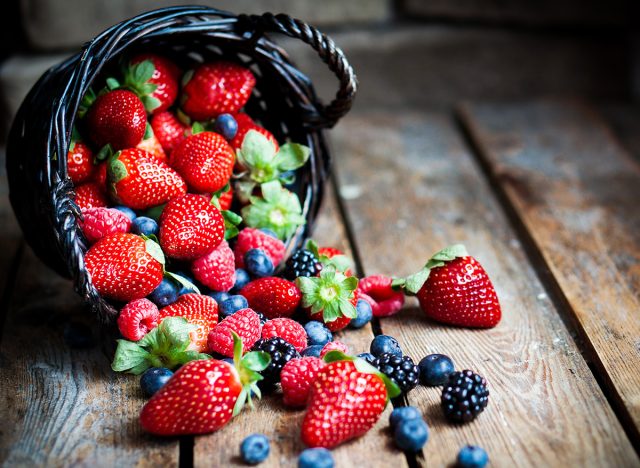
Rich in fiber, vitamins, and antioxidants. Studies have indicated that eating berries regularly can greatly reduce inflammation levels in the body (4). Inflammation is associated with excess belly fat, among other things. The fiber and larger volume you get in a serving of berries are satisfying and help prevent excess hunger later. With the fiber on board, you don't get the blood sugar crash—meaning less chance of rebound food cravings that tend to follow unstable blood sugar patterns.
Beans, pulses, and soluble fiber
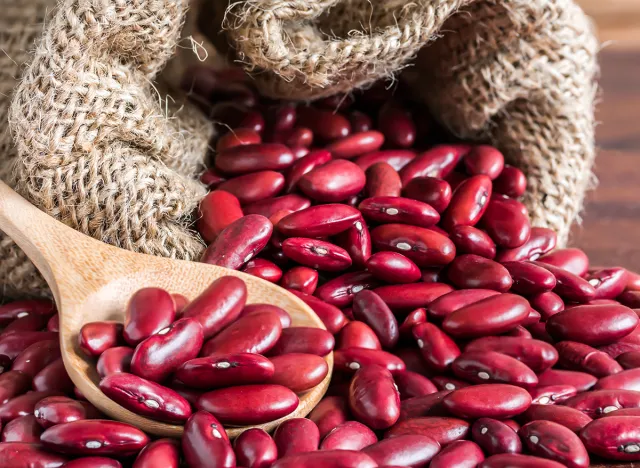
These are sources of low-fat protein and soluble fiber, which likes to grab on to cholesterol in the gut and escort it right on out of the body. To fully earn that 'superfood' status, beans and pulses contain antioxidants. Those with the highest antioxidant abilities (5) include yellow peas, green peas, chickpeas, soybeans, lentils, and red kidney beans.
Beans and pulses are rich in soluble fiber. Soluble fiber absorbs a lot of water in the gut. It slows down the rate our stomach empties after eating (6), and causes the stomach to expand (feel full), thus we are satisfied longer after eating. Soluble fiber also cuts down on the amount of calories the body can absorb from food. (7) A 2-year longitudinal study in Japan found that eating more soluble fiber could be linked with less belly fat. (8) These fibers help trigger the release of gut hormones that signal you've had enough to eat. They are a source of energy for your gut microbes and the cells that line the inside of your intestines. (Again, our gut bacteria control a lot. Seriously. Keep them happy.) Fiber can also range from 0-2 usable calories per gram, compared to the standard 4 calories per gram of other carbohydrates.
Whole grains
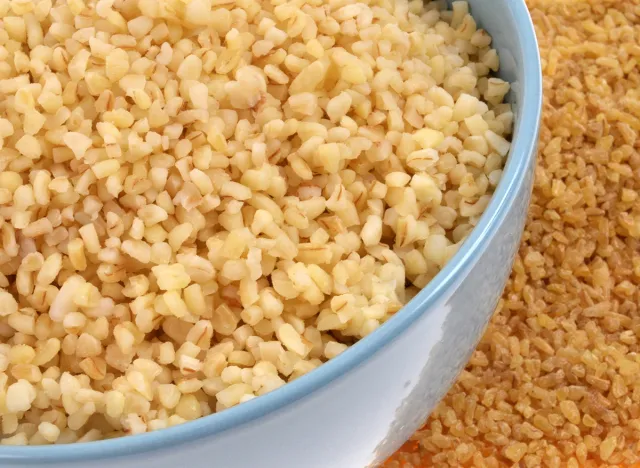
Whole grains are essentially that—the whole, intact grain from the plant. They are not stripped of the outer bran during processing. When left intact, grains have similar nutrient profiles to beans & pulses—though the protein is a bit less. Stripping grains results in refined grains, which are softer and more uniform. Refined grains (aka, all-purpose or white flour) can more quickly spike blood sugar levels after eating and are associated with insulin resistance, excess weight, and type 2 diabetes. The insoluble fiber in whole grains also helps curb hunger and aids in ridding waste from the body. Whole grains include quinoa (not technically a grain, but acts like one), whole oats, bulgur, whole wheat, and more.
Fiber-rich foods also lead to more chewing (9), which in and of itself signals to the body that nutrients are coming in, and digestion can begin. If you've ever been hungry shortly after having a protein drink as your meal, this may be a culprit. Your brain needs physical stimulation from eating.
Related: 11 Ways to Ignite Your Metabolism to Burn Fat All Day
Heart-healthy fats
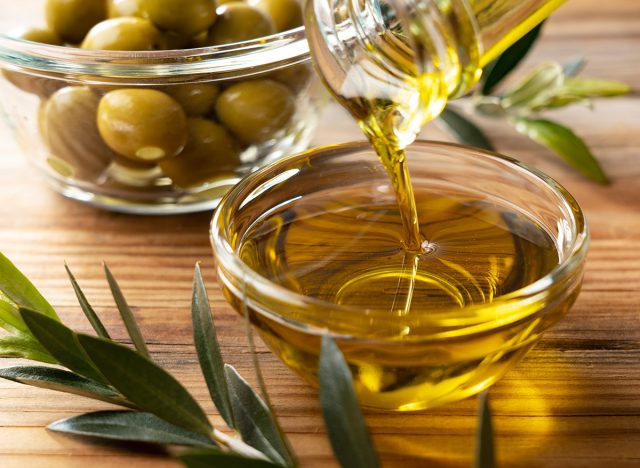
Heart-healthy fats, particularly the monounsaturated type, are found in foods like olive oil, avocados, nuts, and seeds. Diets high in these may be linked to lower body weight (10). The Mediterranean diet is an example of a diet high in these fats, and it's been linked to many (many) health benefits (11).
Compared to less-healthy saturated fats found in animal foods like butter and red meat, unsaturated fatty acids promote energy usage (aka, metabolism), diet-induced thermogenesis (creation of heat), and fat oxidation (breaking down of stored body fat). (12) This would explain why a diet that includes a high amount of unsaturated fatty acids is less prone to cause weight gain. There is evidence showing that replacing saturated fats with monounsaturated fats leads to weight loss and lower fat mass (13).
In the monounsaturated fat category, one notable superstar is the humble avocado. Various studies13 have found that feelings of hunger were significantly less when adding avocado to a meal. This is to be expected with the fat and fiber avocados contain. The studies have also found that insulin production was less. We know that fat is a strong driver of releasing the digestive hormones GLP-1 (aka, what the current popular injectable medications for weight loss help maintain) and PYY. Both of these hormones signal to the brain that adequate nutrition has been consumed (aka, you get full and stay full), and blunt the drive to eat (less appetite) (14,15).
Cinnamon
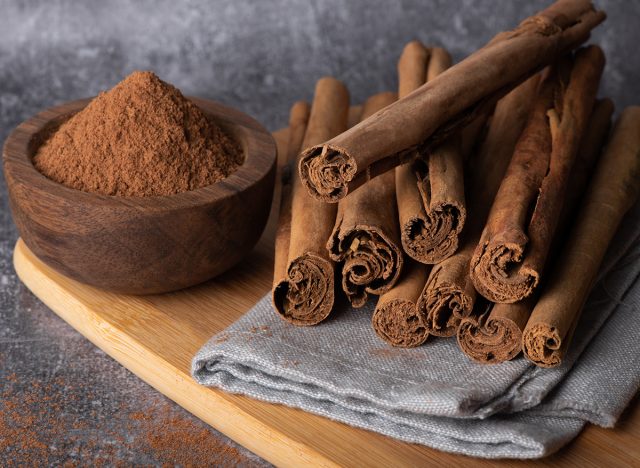
Cinnamon, with its naturally sweet flavor and antioxidants, has been found to cut back on sugar cravings, and is associated with better control of blood sugar in diabetes. It enhances the action of proteins that are involved with sugar (glucose) transport and the insulin signaling pathway. Insulin is a hormone involved in storing blood sugar and storing body fat (16).
The distinct smell and flavor of cinnamon comes from an oily substance that has large amounts of cinnamaldehyde (17). Cinnamaldehyde is thought to be why cinnamon works the way it does (18).
Green tea

Green tea, packed with antioxidants, inhibits the action of the enzymes lipase, amylase, and glucosidase (20-22). Enzymes help the body break down foods and nutrients into smaller pieces, which is needed for proper absorption. Green tea works by preventing enzymes from doing their job in the gut. Stopping the enzyme lipase from working means less fat is absorbed from the foods we eat. The compound EGCG and caffeine are the primary working components of green tea. They possess a wide range of activities in the body, including weight loss.
Coffee, caffeine & chlorogenic acids

Coffee contains the antioxidant chlorogenic acid. To date, it has been found in studies (23,24,29) to contribute to calorie and fat burning, along with activation of brown fat. Brown fat is considered a healthy type of fat and is darker in color. Brown fat is smaller in size (takes up less space) and is packed with energy-producing cells (mitochondria), and it burns calories.
Related: Top 11 Exercises for Leaner, Stronger, Firmer Legs
Ashwagandha
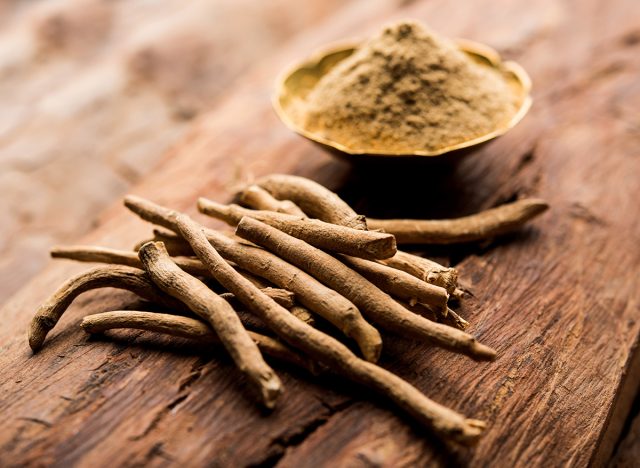
This plant has a long history of use as an adaptogen in ayurvedic medicine. An adaptogen is a substance thought to help the body handle stress better. We know that chronic stress often leads to changes in eating behaviors and food choices, including the drive to eat more. This is due to the hormone cortisol, which kicks in for that fight-or-flight response in times of stress. Cortisol (25) is known to increase hunger and sweet cravings.
Ashwagandha contains several active components that are anti-stress, and extracts of the root offer major anxiety-reducing properties in humans, due to its GABA-like activity in the brain. (GABA (26) is an amino acid-based messenger in the central nervous system, and reduces 'excitement' in the system.) Ease the body's stress response and thus coping behaviors like overeating.
Choudhary and others (27) found in their double-blind, randomized, placebo-controlled trial with 52 subjects over 8 weeks that treatment with Ashawagandha extract resulted in subjects reporting much lower perceived stress scores vs baseline. This mimics findings from another study (28) where stress-related food cravings, reactive eating, serum cortisol levels, and body weight were all less.
For safety: If you're thinking of trying it, please check to make sure it doesn't interact with any medications or other supplements you are taking.
Wine (the resveratrol part)

Resveratrol acts as an antioxidant and is found in berries, nuts, red grapes and products made with them (ahem, wine, or juice). It has been popular for a while now for heart health. In recent years, we've learned (29) that resveratrol is a strong activator of SIRT-1, a protein that helps protect against aging-related metabolic diseases (including those related to blood sugar use in the body). It mimics the effects of restricting food intake by regulating the body's response to fasting, calorie restriction, and exercise.
Getting resveratrol from a dietary supplement is fraught with issues, including low absorption and activity in the body. (Getting it from a pill vs the food itself affects the body's ability to absorb and use it.) Further clinical trials are needed so we can better understand everything resveratrol can do, and how best to apply it to health. In the meantime, if you happen to enjoy an occasional glass of red wine or snacking on some red grapes or berries, it may support weight loss efforts.
Flaxseed
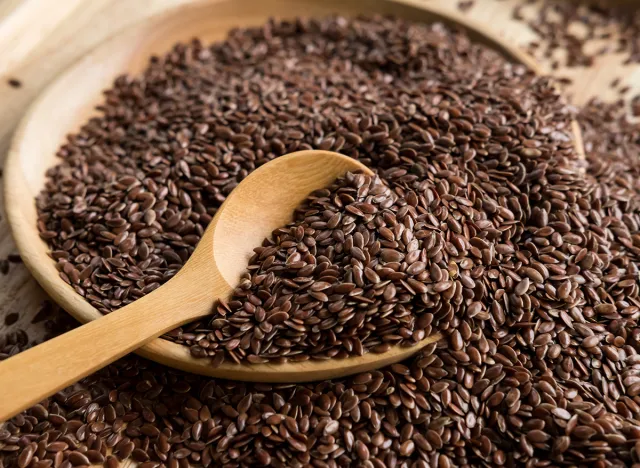
Flaxseed is rich in alpha-linolenic acid (ALA, an omega-3 fatty acid), fiber, and lignans. (30,31) (Lignans are the waterproof "backbone" material for plants, and provide structure, support, and protection.) It's also a great source of quick fiber when added to recipes or other foods. (Recall that fiber = enhanced meal satisfaction.) The lignans from flaxseed are reported to reduce belly fat and increase fat oxidation (burning) and adiponectin levels in a study on mice (31,32,34). Adiponectins33 are released by fat cells, and are involved in managing sugar levels, fat usage, and insulin sensitivity. It has an anti-inflammatory effect and is an antioxidant. Win!
In a large review of 45 randomized, controlled trials (33), significant weight loss was observed in those eating more than 30 grams (3 tablespoons) flaxseed per day, over 12-week periods, and in those of a higher weight range. Scientists suggest that the higher fiber content or other compounds present in flaxseed are responsible for the weight change, and trial results seem to highlight a cumulative effect over time. (The longer you use it and the more consistent you are with it, the more effect you might experience.) This is thought to be related to the active parts of the plant needing to build up in the body tissues over time.
Conjugated linolenic acid (CLA)

Research (35) on CLA (a group of polyunsaturated fatty acids found naturally in meat and dairy products of cud-chewing animals) suggested a link with smaller fat cell size, less ability to make more fat tissue, browning of fat tissue, and changes in gut bacteria. Thus, CLA may be supportive in fat loss and a leaner midsection. Not exactly a superfood, per se, but still part of the conversation.
Diacylglycerol (DAG)
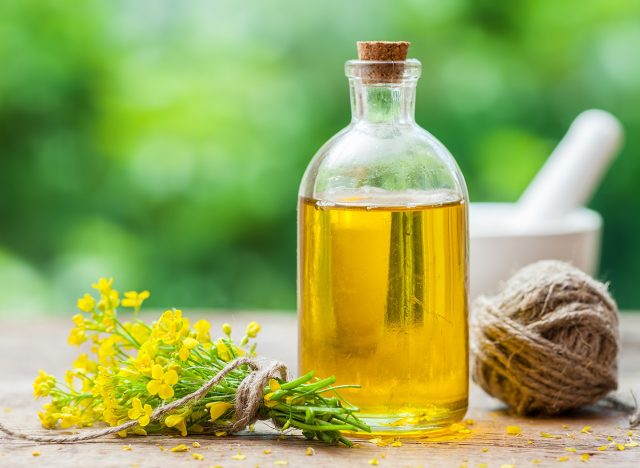
"Dia-what?" you might ask. DAG (36) is a natural part of many edible oils, like canola. It acts differently than similar types of fats (like triglycerides) because it has a different structure. It has been noted to enhance fat oxidation in animal models. (37) When paired with ALA (see previous section), it resulted in excellent outcomes for body weight and belly fat loss (36,37). Cooking with canola oil would be a way to include DAG in your day-to-day eating.
Related: I Lost 100 Pounds Eating the Foods in My New Cookbook
Summing It Up

As you can see from the sheer variety of foods and nutrients that support fat loss, there are some common themes: fiber/gut health, antioxidants, and healthy fats seem to pop up frequently. Some have a direct effect, others are indirect. Consistency over time is also important. In general, it's the effect of multiple compounds in the food working together. Even if you're not consuming these foods or plant compounds for the benefit of fat loss, they still offer major health benefits…so, enjoy!
💪🔥Body Booster: Green tea is a health booster packed with antioxidants that can limit fat absorption by blocking certain enzymes. Its key components, EGCG, and caffeine, work together to aid weight loss.
Annette Snyder has been a registered dietitian (RD) for nearly 20 years. I've had extensive experience in the practice areas of weight management, diabetes care, and digestive disorders. I currently maintain additional board certification (CSOWM) in weight management through the Commission on Dietetic Registration, the credentialing body for the Academy of Nutrition and Dietetics. I'm passionate about the new things nutrition science is teaching us. My goal is sharing that knowledge in a way that inspires others to get curious about their health.
Cited References
- Neeland IJ, Ross R, Després JP, et al. Visceral and ectopic fat, atherosclerosis, and cardiometabolic disease: a position statement. Lancet Diabetes Endocrinol. 2019;7(9):715-725. doi:10.1016/S2213-8587(19)30084-1
- Miketinas DC, Bray GA, Beyl RA, Ryan DH, Sacks FM, Champagne CM. Fiber Intake Predicts Weight Loss and Dietary Adherence in Adults Consuming Calorie-Restricted Diets: The POUNDS Lost (Preventing Overweight Using Novel Dietary Strategies) Study. J Nutr. 2019;149(10):1742-1748. doi:10.1093/jn/nxz117
- Roberts JL, Moreau R. Functional properties of spinach (Spinacia oleracea L.) phytochemicals and bioactives. Food Funct. 2016;7(8):3337-3353. doi:10.1039/c6fo00051g
- Skrovankova S, Sumczynski D, Mlcek J, Jurikova T, Sochor J. Bioactive Compounds and Antioxidant Activity in Different Types of Berries. International Journal of Molecular Sciences. 2015; 16(10):24673-24706. https://doi.org/10.3390/ijms161024673
- Xu BJ, Chang SK. A comparative study on phenolic profiles and antioxidant activities of legumes as affected by extraction solvents. J Food Sci. 2007;72(2):S159-S166. doi:10.1111/j.1750-3841.2006.00260.x
- Akbar A, Shreenath AP. High Fiber Diet. [Updated 2023 May 1]. In: StatPearls [Internet]. Treasure Island (FL): StatPearls Publishing; 2024 Jan-. Available from: https://www.ncbi.nlm.nih.gov/books/NBK559033/
- Hervik AK, Svihus B. The Role of Fiber in Energy Balance. J Nutr Metab. 2019;2019:4983657. Published 2019 Jan 21. doi:10.1155/2019/4983657
- Ozato N, Saito S, Yamaguchi T, et al. Association between Nutrients and Visceral Fat in Healthy Japanese Adults: A 2-Year Longitudinal Study Brief Title: Micronutrients Associated with Visceral Fat Accumulation. Nutrients. 2019;11(11):2698. Published 2019 Nov 7. doi:10.3390/nu11112698
- Miquel-Kergoat S, Azais-Braesco V, Burton-Freeman B, Hetherington MM. Effects of chewing on appetite, food intake and gut hormones: A systematic review and meta-analysis. Physiol. Behav. 2015;151:88–96. doi: 10.1016/j.physbeh.2015.07.017.
- Qian F, Korat AA, Malik V, Hu FB. Metabolic Effects of Monounsaturated Fatty Acid-Enriched Diets Compared With Carbohydrate or Polyunsaturated Fatty Acid-Enriched Diets in Patients With Type 2 Diabetes: A Systematic Review and Meta-analysis of Randomized Controlled Trials. Diabetes Care. 2016;39(8):1448-1457. doi:10.2337/dc16-0513
- Agnoli C, Sieri S, Ricceri F, et al. Adherence to a Mediterranean diet and long-term changes in weight and waist circumference in the EPIC-Italy cohort. Nutr Diabetes. 2018;8(1):22. Published 2018 Apr 25. doi:10.1038/s41387-018-0023-3
- Krishnan S, Cooper JA. Effect of dietary fatty acid composition on substrate utilization and body weight maintenance in humans. Eur. J. Nutr. 2014;53:691–710. doi: 10.1007/s00394-013-0638-z.
- Park E., Edirisinghe I., Burton-Freeman B. Avocado Fruit on Postprandial Markers of Cardio-Metabolic Risk: A Randomized Controlled Dose Response Trial in Overweight and Obese Men and Women. Nutrients. 2018;10:1287. doi: 10.3390/nu10091287.
- Ballantyne G.H. Peptide YY (1–36) and Peptide YY (3–36): Part I. Distribution, Release and Actions. Obes. Surg. 2006;16:651–658. doi: 10.1381/096089206776944959.
- Holst J.J. The Physiology of Glucagon-like Peptide 1. Physiol. Rev. 2007;87:1409–1439. doi: 10.1152/physrev.00034.2006.
- Sharma S, Mandal A, Kant R, Jachak S, Jagzape M. Is Cinnamon Efficacious for Glycaemic Control in Type-2 Diabetes Mellitus?. J Pak Med Assoc. 2020;70(11):2065-2069.
- National Center for Biotechnology Information. PubChem Compound Summary for CID 637511, Cinnamaldehyde. https://pubchem.ncbi.nlm.nih.gov/compound/Cinnamaldehyde. Accessed Jan. 29, 2024.
- Zuo J, Zhao D, Yu N, et al. Cinnamaldehyde Ameliorates Diet-Induced Obesity in Mice by Inducing Browning of White Adipose Tissue. Cell Physiol Biochem. 2017;42(4):1514-1525. doi:10.1159/000479268
- Kim SH, Plutzky J. Brown Fat and Browning for the Treatment of Obesity and Related Metabolic Disorders. Diabetes Metab J. 2016;40(1):12-21. doi:10.4093/dmj.2016.40.1.12
- Grove K.A., Sae-tan S., Kennett M.J., Lambert J.D. (-)-Epigallocatechin-3-gallate inhibits pancreatic lipase and reduces body weight gain in high fat-fed obese mice. Obesity. 2012;20:2311–2313. doi: 10.1038/oby.2011.139.
- Rothenberg D.O., Zhou C., Zhang L. A Review on the Weight-Loss Effects of Oxidized Tea Polyphenols. Molecules. 2018;23:1176. doi: 10.3390/molecules23051176.
- Vázquez Cisneros LC, López-Uriarte P, López-Espinoza A, Navarro Meza M, Espinoza-Gallardo AC, Guzmán Aburto MB. Efectos del té verde y su contenido de galato de epigalocatequina (EGCG) sobre el peso corporal y la masa grasa en humanos. Una revisión sistemática [Effects of green tea and its epigallocatechin (EGCG) content on body weight and fat mass in humans: a systematic review]. Nutr Hosp. 2017;34(3):731-737. Published 2017 Jun 5. doi:10.20960/nh.753
- Velickovic K., Wayne D., Leija H.A.L., Bloor I., Morris D.E., Law J., Budge H., Sacks H., Symonds M.E., Sottile V. Caffeine exposure induces browning features in adipose tissue in vitro and in vivo. Sci. Rep. 2019;9:9104. doi: 10.1038/s41598-019-45540-1.
- Stefanello N., Spanevello R.M., Passamonti S., Porciuncula L., Bonan C.D., Olabiyi A.A., Teixeira da Rocha J.B., Assmann C.E., Morsch V.M., Schetinger M.R.C. Coffee, caffeine, chlorogenic acid, and the purinergic system. Food Chem. Toxicol. 2019;123:298–313. doi: 10.1016/j.fct.2018.10.005.
- Epel E, Lapidus R, McEwen B, Brownell K. Stress may add bite to appetite in women: A laboratory study of stress-induced cortisol and eating behavior. Psychoneuroendocrinology. 2001;26:37–49. doi:10.1016/S0306-4530(00)00035-4.
- Allen MJ, Sabir S, Sharma S. GABA Receptor. [Updated 2023 Feb 13]. In: StatPearls [Internet]. Treasure Island (FL): StatPearls Publishing; 2024 Jan-.Available from: https://www.ncbi.nlm.nih.gov/books/NBK526124/
- Choudhary D, Bhattacharyya S, Joshi K. Body Weight Management in Adults Under Chronic Stress Through Treatment With Ashwagandha Root Extract: A Double-Blind, Randomized, Placebo-Controlled Trial. J Evid Based Complementary Altern Med. 2017;22(1):96-106. doi:10.1177/2156587216641830
- Chandrasekhar K, Kapoor J, Anishetty S. A prospective, randomized double-blind, placebo-controlled study of safety and efficacy of a high-concentration full-spectrum extract of ashwagandha root in reducing stress and anxiety in adults. Indian J Psychol Med. 2012;34:255–262. doi:10.4103/0253-7176.106022.
- Lagouge M., Argmann C., Gerhart-Hines Z., Meziane H., Lerin C., Daussin F., Messadeq N., Milne J., Lambert P., Elliott P., et al. Resveratrol improves mitochondrial function and protects against metabolic disease by activating SIRT1 and PGC-1alpha. Cell. 2006;127:1109–1122. doi: 10.1016/j.cell.2006.11.013.
- Parikh M, Maddaford TG, Austria JA, Aliani M, Netticadan T, Pierce GN. Dietary Flaxseed as a Strategy for Improving Human Health. Nutrients. 2019;11(5):1171. Published 2019 May 25. doi:10.3390/nu11051171
- Liu Q, Luo L, Zheng L. Lignins: Biosynthesis and Biological Functions in Plants. Int J Mol Sci. 2018;19(2):335. Published 2018 Jan 24. doi:10.3390/ijms19020335
- Kristensen M., Jensen M.G. Dietary fibres in the regulation of appetite and food intake. Importance of viscosity. Appetite. 2011;56:65–70. doi: 10.1016/j.appet.2010.11.147.
- Nguyen TMD. Adiponectin: Role in Physiology and Pathophysiology. Int J Prev Med. 2020;11:136. Published 2020 Sep 3. doi:10.4103/ijpvm.IJPVM_193_20
- Mohammadi-Sartang M., Mazloom Z., Raeisi-Dehkordi H., Barati-Boldaji R., Bellissimo N., Totosy de Zepetnek J.O. The effect of flaxseed supplementation on body weight and body composition: A systematic review and meta-analysis of 45 randomized placebo-controlled trials. Obes. Rev. 2017;18:1096–1107. doi: 10.1111/obr.12550.
- Kim B., Lim H.R., Lee H., Lee H., Kang W., Kim E. The effects of conjugated linoleic acid (CLA) on metabolic syndrome patients: A systematic review and meta-analysis. J. Funct. Foods. 2016;25:588–598. doi: 10.1016/j.jff.2016.07.010.
- Flickinger B.D., Matsuo N. Nutritional characteristics of DAG oil. Lipids. 2003;38:129–132. doi: 10.1007/s11745-003-1042-8.
- Ando Y., Saito S., Miura H., Osaki N., Katsuragi Y. Consumption of alpha-linolenic acid-enriched diacylglycerol induces increase in dietary fat oxidation compared with alpha-linolenic acid-enriched triacylglycerol: A randomized, double-blind trial. Nutr. Res. 2017;48:85–92. doi: 10.1016/j.nutres.2017.10.012.




